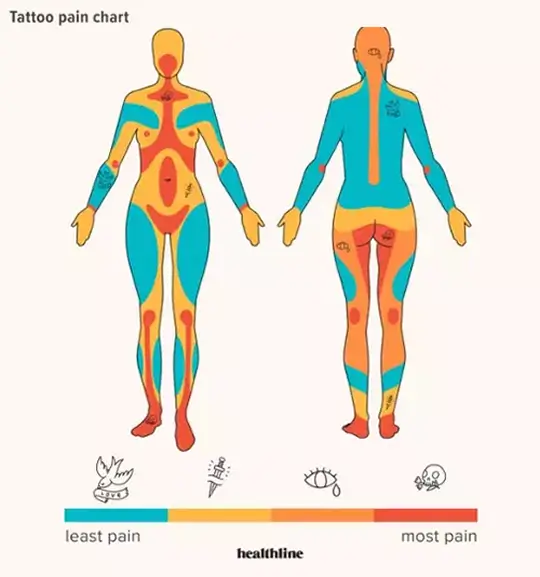Tattoo PainChart
Tattoo Pain Chart which parts of your body experience the most pain from paramedical tattoos?


Our Tattoo Pain Chart was developed using data from the general population, and it may not accurately reflect your experience.
People’s pain tolerances differ significantly, even while obtaining camouflage tattoos on identical body parts.
Be mindful that paramedical tattoos can cause varying degrees of pain depending on whether the receiver has nerve impairment at the site of the scar, which stops them from feeling pain, or nerve sensitivity at the site of the scar, which intensifies the sensitivity.
Pain Reduction Techniques
Tattoo pain can be mitigated in a number of ways, including the use of pre-treatment pain relievers like Tylenol, the application of ice to the area, and, in very rare cases, the application of a topical anesthetic.
Keep in Mind That Getting a Tattoo Is a Painful Process for Everyone. Getting a tattoo is, at the very least uncomfortable for most people, as the needles are puncturing the skin hundreds if not thousands of times. When getting a tattoo, the level of discomfort varies from person to person and even from spot to spot on the body.
Most sensitive areas For Tattoos
- Armpit
- Rib Cage
- Ankles and Shins
- Nipples and breasts, also known as boob tattoos
- Groin
- Elbows and Knee Caps
- Back of the knee
- Hips
- Neck and Spine
- Head, Face, Ears
- Lips
- Hands, Fingers, Feet, Toes
- Stomach
- Inner Bicep
- Tattoos under butt



Less sensitive areas For Tattoos
- Hairline tattoos and full head tattoos are also known as scalp micro pigmentation
- Bicep tattoos
- Tattoos on the buttocks
- Tattoos on the outer abdomen
- Shoulder tattoos
- Front of the area surrounding the knee tattoos.
Least sensitive areas For Tattoos
- Upper outer thighs
- Forearm
- Outer shoulders
- Outer Bicep
- Calves
- Upper and lower back tattoos
All that being said, most of my clients rate the pain of having a camouflage tattoo at about a 4-5 on the pain scale of 1-10.
Never Forget The Motivation behind your tattoo.
The pain is momentary, but your camouflage tattoos will last for years. If we have to endure pain and discomfort for a few hours, will it be worthwhile? We can probably all agree that it will be.
How to prepare For Tattoo
Doing your homework before going to the studio will help you prepare for what to expect and avoid surprises. The internet has made this a simple task. In preparation for the session, this should help calm your nerves. If you’re nervous about getting your first tattoo because you don’t know what to expect not to worry, as, during your consultation at Illusions by Ink Studio, we will break down:
01 How to prepare for your medical tattoo
02 What to expect during your tattoo
03 What to expect after your tattoo.
When you are preparing for a tattoo, You Should:
Make Sure to Fuel Up and Bring Snacks
Before getting your tattoo, it’s a good idea to have a healthy meal to boost your energy levels. To avoid feeling exhausted and unmotivated during the session, try doing this. If you’re feeling dizzy or queasy, eat something sweet before your workout.
Do not hesitate to inform your artist if you feel ill and need a break to rest and get some fresh air. If your energy reserves begin to dwindle, we also maintain a selection of beverages and snacks on hand.
Stay hydrated
Water is essential to consume in the 24 hours following your visit. To keep your body in tip-top shape, it’s recommended that you drink eight 8-ounce glasses of water per day. In addition to improving your health, drinking plenty of water before getting a tattoo will help keep your skin supple and healthy. Your artist will have an easier time getting a good tattoo on hydrated skin than on dry skin.
Dress in loose, at ease garments
You must feel relaxed in the chair, and wearing loose, comfortable clothing can significantly aid this.
Focusing on the discomfort caused by your tight shorts is counterproductive if you constantly adjust your position. Plan your next move logically, i.e., wear a vest or tank top if you plan on getting your upper arms tattooed.
Stay away from some medicines, sugary and dairy based products.
We highly recommend waiting at least two days after taking blood-thinning medications like aspirin or ibuprofen before getting your scar camouflage tattoo. Increased bleeding throughout the session makes it more difficult for the artist to view their work and decreases the ink saturation levels.
Also, avoid eating sugary or dairy-based foods in the days following your appointment. Sugar and dairy products have been shown to slow down the recovery process.
Keep a positive outlook
Keeping a positive mindset in the face of hardship has already been emphasized. If you go into the day with a good frame of mind, you will be able to look back and be pleased with your new tattoo and how you handled the event.
Sleeping well the night before can be helpful.
One of the worst parts of life is being forced to sit for extended periods when you’re exhausted or hungover.
You should feel good and refreshed to get the most out of the experience. You might be irritable and fidgety if you don’t get enough sleep the night before getting a tattoo. This will also make the pain even more intolerable.
Listen to your artist’s critiques and suggestions
At Illusions by Ink Studio, we care about our clients and want the camouflage tattoo experience to be as comfortable and painless as possible.
If you follow the How to Prepare for your Camouflage Tattoo instructions given at your consult, your appointment will go more smoothly. We may also recommend breaks to eat, drink, use the restroom, or grab some fresh air during our session.
Find something to chew on or a stress ball to fidget with
If you choose, you can tension the muscles in the part of your body that isn’t getting the tattoo. You can also alleviate pain by squeezing something in your hand or chewing on it. You can also bring a stress ball, a grip exerciser, some gum, and some soft candies. Even when the pain is at its worst, you can take a deep breath and relax.
Breathe!
Research has found that the most efficient technique of pain management is deep, steady breathing, similar to what a woman would do during labor. It is thought that this technique lessens the impact of pain. Assess the skin’s health to ensure it can withstand the camouflage tattoo.
Before coming in for your camouflage tattoo, it’s important that your scar is free from blisters, wounds, or sunburn. Taking good care of yourself in the days leading up to your appointment can greatly enhance the likelihood of a smooth and successful recovery. We have doctors who refer patients to us for scar camouflage starting from 90 days to 6 months after their procedure, depending on the condition of the scar.
Spend some time listening to music or reading an audiobook
You should take part in whatever helps ease the pain. The pain of getting a tattoo is real, but turning on your favorite record and listening to it can help you forget about it for a bit.
Having a conversation with your artist is encouraged if they don’t mind
Though some artists might be too focused on their work to start a conversation with you, most tattoo artists are friendly and eager to talk with their customers.
When it comes to alleviating pain, this is the one technique that has ever proven effective for me. Time spent with someone who can inspire you can seem to disappear if you can initiate a conversation.
Meditation and controlled breathing are great ways to train your mind to focus
For some, this may work out well, while for others, it may have no effect at all. My attention wanders so much while getting a medical tattoo that it’s hard to keep my breath even. However, many who try it claim to have good results.
To test how deeply you can breathe, focus on doing so. Start by taking ten deep breaths, then take ten more.
If those methods don’t help, you can always look into alternative medicinal treatments. Again, this varies greatly from person to person depending on things
How painful is it going to be to get This Tattoo?
If you’re wondering if getting a tattoo will hurt, the answer is yes. Regardless of where your tattoo lands on a pain scale, hundreds of tiny needles will be puncturing your skin every minute. For 99 percent of people, this will be at least a little uncomfortable, as pain signals will spread throughout their entire body.
The tattoo placement on the body is crucial because that is where it will be viewed the most. A tattoo on the rib cage will almost always be more painful than getting one on an arm or leg.
Pain charts and scales help prepare for the potential agony of getting a tattoo, but they can only give you an approximate idea of the strength of the feelings your nerve endings may experience throughout the tattooing procedure.
A person with a low pain tolerance will feel the agony of a tattoo more acutely than someone with a high pain tolerance. It’s a common misconception that having a tattoo is painful, but that’s not the case.
Learn more about tattoo pain management and common concerns in our Scar Camouflage Tattoo FAQ.
